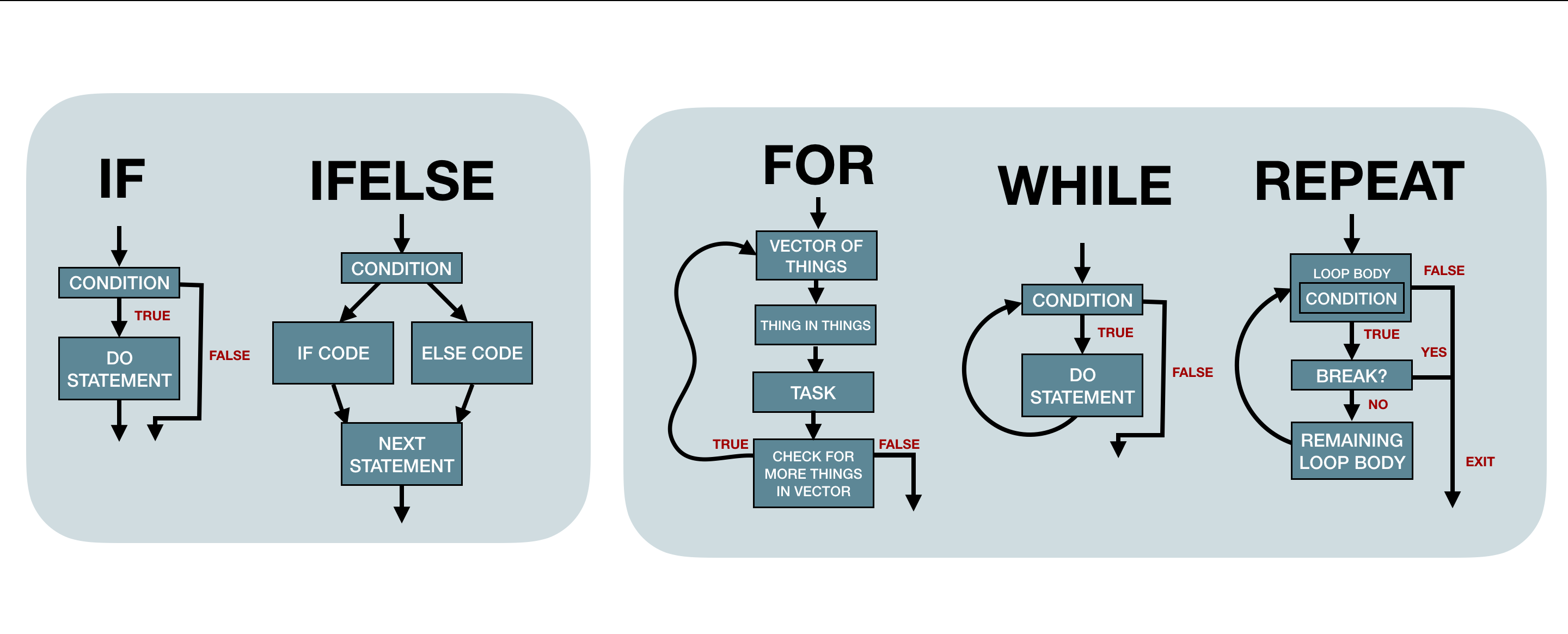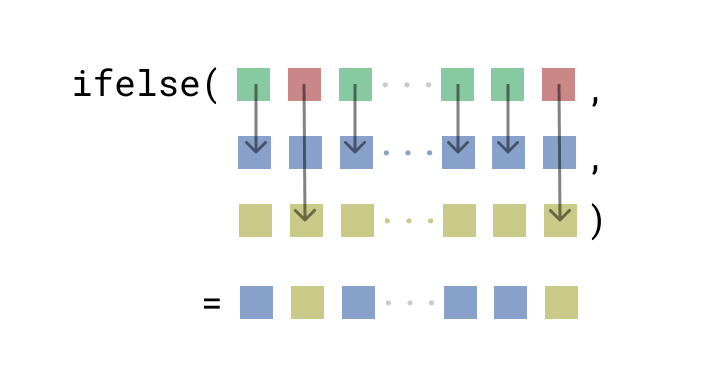Chapter 5 Control Flow
5.2.2 Vectorised if
Why does if else print "Out of range" once but ifelse prints it twice?
[1] "Out of range"[1] "Out of range"
[1] "Out of range"NULL## [1] "Out of range"## [1] "Out of range"ifelse explicitly returns its result, whereas if invisibly returns it!
## [1] 1 3 1Honestly, ifelse() is weird. Try this too:
## [1] 1 3 35.3 Loops
Can the body of the loop change the set?
## [1] "hello"
## [1] 1 20 99 NA NA NA NA NA 20
## [1] "hello"
## [1] 1 20 99 NA NA NA NA NA 20
## [1] "hello"
## [1] 1 20 99 NA NA NA NA NA 20Looks like you can’t!
5.2.3 switch statement
“Closely related to if is the switch() statement. It’s a compact, special purpose equivalent”
What is meant here by “special purpose”? Can we come up with a case where you can’t substitute if for switch or the other way around? Use switch. Is it safe to say to switch when you have character inputs (as the book suggests) and use case_when or if for numerics?
Switch is special in that only ONE value can be true, as in the case from our presentation the shiny input can only ever be ONE of the strings on the left it cannot be multiple.
5.3.1 common pitfalls
What does the book mean by leveraging vector for preallocating the loop output? How is this different from creating an empty list to instantiate the loop?
By preallocating the length of the out_vector we’re leveraging modify-in-place rather than copy-on-modify.
The book warns against using length(x) and suggests using seq_along instead. Is there any downside to using seq_along or a case when you’d prefer length(x) over seq_along(x)? I can’t think of any downsides to using it!
We have yet to find a downside but should look into this further!
5.3.3.1 Exercises
## [[1]]
## [1] NAI understand that this works because we can count down in a loop - so the first iteration x[1] == NA, and the second x[2] == numeric(0) but where does this value go? Is it just evaluated but not stored since R counts from 1?
This question is actually the bigger question, “Can you assign something to index 0 in R?” and it doesn’t seem that you can.
Assignment to a valid index
## [[1]]
## [1] "something"Assignment to [0]
## list()It’s interesting that it’s syntactically correct to assign to mylist[0] but it does nothing!
Empty index
## [[1]]
## NULLR defaultly accesses the first layer using [ and says there are no elements in the first layer of mylist and returns NULL. But when you do mylist[[1]] R says Out of Bounds because the first layer of mylist has been called and there is no layer at all. That’s why R throws error in [[ case.
Impossible Index [[
Error in mylist[[0]] : attempt to select less than one element in get1index <real>[[ isolates one element whereas [ can be used to get subsets of varying sizes.
[[ gets precisely one element, no more no less, or it fails. So [[0]]<- cannot work because index zero cannot hold a value.
Impossible Index [[<-
Error in mylist[[0]] <- "something" : attempt to select less than one element in integerOneIndexUndefined name
Selection using an undefined - but possible name - gives NULL
Out of Bounds
Selection using a possible - but not currently allocated - index gives an out of bounds error
Error in mylist[[10]] : subscript out of bounds Conclusion
Can we put these concepts together in diagram form? Let’s work on improving these schematics!
Let’s first put functions into words:
- If condition then run code, else quit
- A vectorized version of: if condition then run code, else run other code
- For every element in list of elements do what is in between the curly braces
- While this condition is true do this
- Repeat this until something tells you to break out

We can visualize how the ifelse logic on a single element above will operate on each element within a vector:

For instance if we can run:
## [1] 1 3 1Lets break down what’s happening:
Create a test answer:
which indices in the test are TRUE and which are FALSE
set up our answer
grow the yes and no answers to the length of the test (input)
fill the answer with yes or no from the enlarged yes/no answers
return our final answer:
## [1] 1 3 1Another example: we can run
## [1] "1" "FALSE" "3" "FALSE" "5" "6"we can see that ifelse places the numbers in 1:10 based on their index where our condition is to TRUE and inserts the string "FALSE" whenever the condition is FALSE
Complexity
Cyclomatic complexity is a software metric used to indicate the complexity of a program. It is computed using the control flow graph of the program: the nodes of the graph correspond to indivisible groups of commands of a program, and a directed edge connects two nodes if the second command might be executed immediately after the first command.
We can use the package cyclocomp to look at the cyclomatic complexity of functions. Looking at each function from the Chapter 5 presentation:
controlflow_functions <- list(
if_func = if_func,
if_else_func = if_else_func,
ifelse_func = ifelse_func,
casewhen_func = casewhen_func,
switch_func = switch_func,
for_func = for_func,
while_func = while_func,
repeat_func = repeat_func)
purrr::map_df(controlflow_functions, cyclocomp)## # A tibble: 1 x 8
## if_func if_else_func ifelse_func casewhen_func switch_func for_func while_func
## <int> <int> <int> <int> <int> <int> <int>
## 1 2 2 1 1 1 23 3
## # … with 1 more variable: repeat_func <int>We see that the for loop was our most complex function and while had a complexity of 3. The rest of our functions had a complexity of 1.
As Colin Fay states:
“Splitting a complex function into smaller functions is not a magic solution because (A) the global complexity of the app is not lowered by splitting things into pieces (just local complexity), and (B) the deeper the call stack, the harder it can be to debug.”